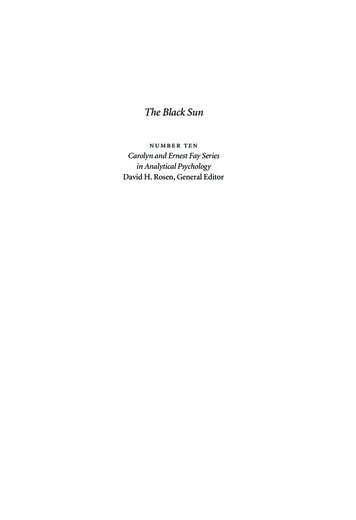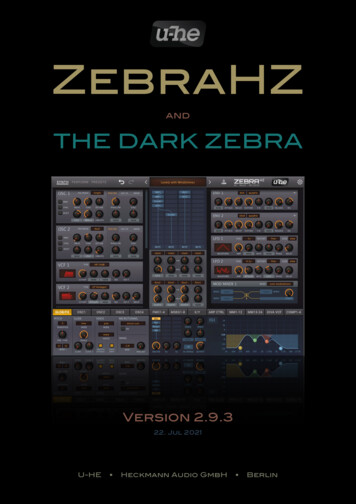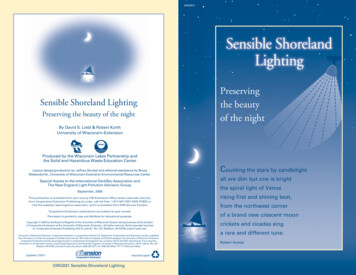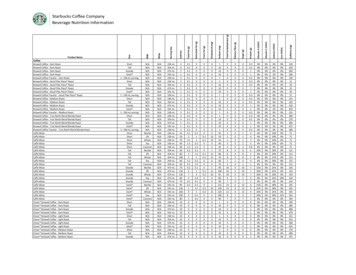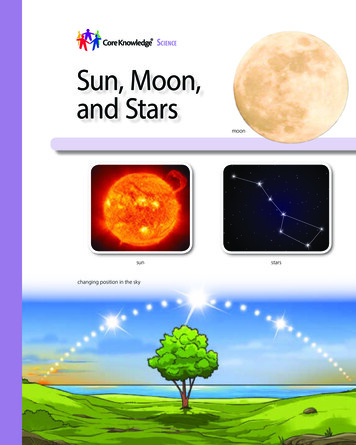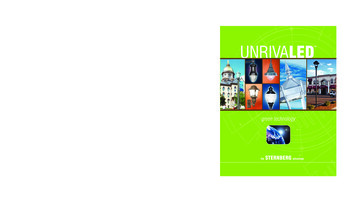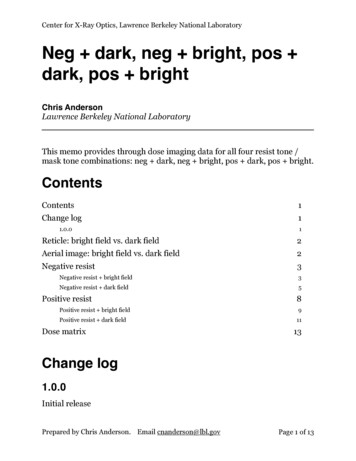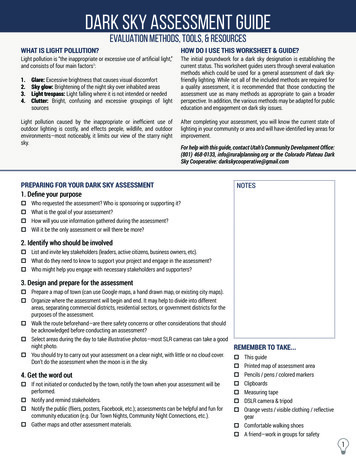
Transcription
DARK SKY ASSESSMENT GUIDEEVALUATION METHODS, TOOLS, & RESOURCESWHAT IS LIGHT POLLUTION?Light pollution is “the inappropriate or excessive use of artificial light,”and consists of four main factors1:1.2.3.4.Glare: Excessive brightness that causes visual discomfortSky glow: Brightening of the night sky over inhabited areasLight trespass: Light falling where it is not intended or neededClutter: Bright, confusing and excessive groupings of lightsourcesLight pollution caused by the inappropriate or inefficient use ofoutdoor lighting is costly, and effects people, wildlife, and outdoorenvironments—most noticeably, it limits our view of the starry nightsky.HOW DO I USE THIS WORKSHEET & GUIDE?The initial groundwork for a dark sky designation is establishing thecurrent status. This worksheet guides users through several evaluationmethods which could be used for a general assessment of dark skyfriendly lighting. While not all of the included methods are required fora quality assessment, it is recommended that those conducting theassessment use as many methods as appropriate to gain a broaderperspective. In addition, the various methods may be adapted for publiceducation and engagement on dark sky issues.After completing your assessment, you will know the current state oflighting in your community or area and will have identified key areas forimprovement.For help with this guide, contact Utah’s Community Development Office:(801) 468-0133, info@ruralplanning.org or the Colorado Plateau DarkSky Cooperative: darkskycooperative@gmail.comPREPARING FOR YOUR DARK SKY ASSESSMENT1. Define your purposeNOTES Who requested the assessment? Who is sponsoring or supporting it? What is the goal of your assessment? How will you use information gathered during the assessment? Will it be the only assessment or will there be more?2. Identify who should be involved List and invite key stakeholders (leaders, active citizens, business owners, etc). What do they need to know to support your project and engage in the assessment? Who might help you engage with necessary stakeholders and supporters?3. Design and prepare for the assessment Prepare a map of town (can use Google maps, a hand drawn map, or existing city maps). Organize where the assessment will begin and end. It may help to divide into differentareas, separating commercial districts, residential sectors, or government districts for thepurposes of the assessment. Walk the route beforehand—are there safety concerns or other considerations that shouldbe acknowledged before conducting an assessment? Select areas during the day to take illustrative photos—most SLR cameras can take a goodnight photo. You should try to carry out your assessment on a clear night, with little or no cloud cover.Don’t do the assessment when the moon is in the sky.REMEMBER TO TAKE. This guide Printed map of assessment area4. Get the word out Pencils / pens / colored markers If not initiated or conducted by the town, notify the town when your assessment will beperformed. Clipboards Measuring tape Notify and remind stakeholders. DSLR camera & tripod Notify the public (fliers, posters, Facebook, etc.); assessments can be helpful and fun forcommunity education (e.g. Our Town Nights, Community Night Connections, etc.). Orange vests / visible clothing / reflectivegear Gather maps and other assessment materials. Comfortable walking shoes A friend—work in groups for safety1
DARK SKY ASSESSMENT GUIDETABLE OF CONTENTS3 DARK SKY LIGHTING BASICSLighting shielding.3Appropriate lighting levels.3Lighting color.4Essential takeaways.4Acceptable lighting types.56 CONDUCTING A FORMAL AUDITBasic audit guidelines.6Lighting inventory equipment.6Lighting inventory template #1.7Lighting inventory template overview.8-11Lighting inventory template #2.12Taking a sky quality survey.1314 DIFFERENT ASSESSMENT TOOLSMobile apps and resources. 14Who can I contact for help?. 14Lighting issue concerns and land use. 15Public engagement & education. 15Marking a map. 16Taking night photos. 16Calculate the savings. 17SWOT analysis. 1819 AFTER YOUR ASSESSMENTDebrief after the assessment.19Form a local dark skies group.19Pursue Dark Sky Place Certification.19Plan action.19GENERAL LIGHTING TERMSCLUTTER: Bright, confusing and excessive groupings of light sources.COLOR SPECTRUM: Refers to the portion of the electromagneticspectrum that is visible to the human eye.CORRELATED COLOR TEMPERATURE (CCT): Specifies the colorappearance of light emitted by a lamp.DARK SKY: Denoting or located in a place where the darkness of thenight sky is relatively free of interference from artificial light.DSLR CAMERA: “Digital single-lens reflex” or DSLR cameras areversatile cameras with changeable lenses that produce high-qualityphotos.FIXTURE: The assembly that holds the lamp in the lighting systemand includes elements such as a reflector (mirror) or refractor (lens),the ballast, housing, and the attachment parts.FOOTCANDLE (fc): Illuminance produced on a surface that iseverywhere one foot from a uniform point source of light of onecandle and equal to one lumen per square foot.FULLY SHIELDED: A fixture that allows no emission above a horizontalplane passing through the lowest light-emitting or light-reflecting partof the fixture.GLARE: Excessive brightness that causes visual discomfort.KELVIN: A measurement unit for light’s “warmness” or “coolness.”KILOWATT (Kw): A measure equal to1,000 watts of electrical power.KILOWATT HOUR (kWh): A measure of electrical energy equivalent toa power consumption of 1,000 watts for 1 hour.LAMP: A device for giving light which can consist of an electric bulbwith its holder and shade or cover, or one burning liquid fuel andconsisting of a wick or mantle and a glass shade.LIGHT TRESPASS: Light falling where it is not intended or needed.LUMEN: A measurement unit for the brightness from a light source.LUMINAIRE: A complete lighting unit that usually includes the fixture,ballasts, and lamps.LUX: One lumen per square meter. Unit of illuminance.20 ADDITIONAL RESOURCESGeneral resources.20Recreation Lighting.20Flag Lighting.20Illumination standards.20REFLECTION: Light redirected back into the sky off of surfaces thatare being illuminated.SKYGLOW: Brightening of the night sky over inhabited areas.WATT: The standard unit of power in the International System ofUnits (SI).2
DARK SKY ASSESSMENT GUIDESH I ELDINRShieldingAppropriate lighting levelsLighting colorCOLO1.2.3.LIGHTING LEVELSWe need lighting for safety at night. However, many city lights are undirected and waste energywhile causing light pollution. Proper lighting begins with proper lighting design standards whichform a proverbial “three-legged stool”. The legs of the stool are:GDARK SKY LIGHTING BASICS: THE “THREE-LEGGED STOOL”These three basic design principles form the basis for good lighting design, and when appliedcorrectly, will reduce light pollution.1. LIGHTING SHIELDINGUNSHIELDEDPARTIALLY SHIELDEDFULLY SHIELDEDOutdoor lighting should be “fully shielded,”meaning no light above a 90-degree angle. Thegoal of fully shielded light fixtures is to prevent: Light trespass is light falling where it isnot wanted or needed. Light trespasscan create problems for neighboring anddistant properties.Glare is intense and blinding light thatcan cause discomfort and temporaryblindness.Skyglow reduces our ability to viewcelestial objects due to scattered lightfrom sources on the ground.The more light is directed towards the intendedsubject, the better. Fully shielded lighting canbe purchased or retrofitted.2. APPROPRIATE LIGHTING LEVELSOutdoor lighting can easily become excessive or “cluttered.” Appropriate lighting levelsmeans practically managing the amount of outdoor lighting in terms of durationand illuminated area. Ordinances that support appropriate lighting levels will specifythe acceptable amount of lumens within an area (such as lumens per acre). Manymunicipalities use illumination guidelines established by the Illuminating EngineeringSociety (IES) to set lighting levels in their ordinances. In addition municipalities willremove lights no longer in use or needed. Note that International Dark Sky Association(IDA) standards are more strict than IES standards. Lumens are a measurement unit of the brightness from a light source.Clutter is excessive groupings of light sources that create a bright and confusingenvironment.Reflection off of what is being illuminated causes light to be redirected back intothe sky, contributing to sky glow.Timers, motion sensors, dimmer switches, and turning lights off when not in use canhelp improve lighting levels.Generally, uselighting where it’sneeded, when it’sneeded, and only asbright as needed.3
DARK SKY ASSESSMENT GUIDE3. LIGHTING COLORNOTESThe color of the light is important as well. Cool,blue spectrum lights brighten the night skymore than amber colored light and researchersare beginning to connect blue light spectrumto negative health effects in people and greaterproblems for wildlife. IDA recommends using longwavelength lighting with a color temperature of 3000 Kelvin. Kelvin refers to a temperature scale used tomeasure light’s warmness or coolness.Color Spectrum refers to the portion of theelectromagnetic spectrum that is visible tothe human eye.WARM SPECTRUMCOOL SPECTRUM 3000 KESSENTIAL TAKEAWAYS LIGHT ONLY WHAT YOU NEED: Use fully shielded fixtures. Shinelights down, not up. Direct lighting at desired areas. Be strategicwith lighting and only use it where needed. LIGHT ONLY WHEN YOU NEED: Install timers, motion sensors,and dimmer switches, and turn off lights when not in use. LIGHT ONLY HOW MUCH YOU NEED: Use the right amount oflight. Save electricity by using the lowest adequate wattagebulbs. Too much light is wasteful, impairs vision, and can becostly. LIGHT ONLY HOW YOU NEED: Use long-wavelength lights witha red or yellow tint to minimize negative health effects. Usewarmer colored bulbs, like yellow or amber instead of white.Avoid bluish light, which is known to have a variety of negativeeffects.ADAPTED FROM THE INTERNATIONAL DARK-SKY ASSOCIATION, DARKSKY.ORG4
DARK SKY ASSESSMENT GUIDEACCEPTABLE LIGHTING TYPESThe images below illustrate various acceptable lighting forms. For more informations, visit IONS BY BOB CRELIN . RENDERED FOR THE TOWN OF SOUTHHAMPTON, NY. COURTESY OF INTERNATIONAL DARK-SKY ASSOCIATION.5
DARK SKY ASSESSMENT GUIDECONDUCTING A FORMAL LIGHTING AUDITThe IDA requires formally designated Dark Sky Communities (DSC) to adopt a quality and comprehensive lighting code which includes acommitment to a brightness measurement program. The brightness measurement program can be maintained either by the communityor by another public or private organization. The measurement program is meant to monitor success in reducing light pollution. A formallighting audit should be performed to establish a baseline for monitoring success.A formal audit may require outside help from organizations such as a university, research center, IDA chapter, astronomy club, or otherqualified entities since determining the electrical, physical, and operational characteristics of lighting can be difficult or technical. Theprocess for lighting audits vary depending on the organization; however, the Federal Department of Energy (DOE) recommends severalbasic guidelines.BASIC LIGHTING AUDIT GUIDELINESTHE FOLLOWING ITEMS ARE RECOMMENDED FOR CONSIDERATION: The age, condition, quality, and location of existing light fixtures.A lighting audit Model and manufacturer of lighting system to obtain existing photometrics(perceived brightness).provides benchmarks Lamp wattage and ballast type (if appropriate).for determining Take note of the environment, is there the possibility of particulate, moisture, ordirt buildup in or around the lighting fixture? Take note of what kinds of activities, or uses are being performed in the space. Arethere are special visual requirements? Observe how the lighting system is controlled and how often it is used. Note the perceived color of the lighting, e.g. blue, white, or amber light. Measure the physical layout of the existing lighting system and take note of heightand spacing. If possible, use an illuminance meter to measure light intensity. Readings shouldbe taken on the ground and at even intervals to create a “grid” of measurements.the effectivenessof lightingimprovements andenergy savings.ADAPTED FROM THE FEDERAL DEPARTMENT OF ENERGY EXTERIOR LIGHTING AUDIT GUIDELINESUSEFUL MEASUREMENT EQUIPMENTON HANDOPTIONAL EQUIPMENT TAPE MEASURE DSLR CAMERA(see pg. 15) SMART PHONE(see pg. 13) LIGHT METER COLOR TEMPERATUREMETER SKY QUALITY METER LASER DISTANCE METEREQUIPMENT RENTALThe Colorado Plateau Dark Sky Cooperative hassome equipment available to rent for free! Contactdarkskycooperative@gmail.com for more information.Available: Sky Quality Meter (SQM) - 1 available Laser Distance Meter - 2 availableOPTIONAL EQUIPMENT? Light Meter an instrument used to measure the intensity of light.Color Temperature Meter a device used to measure color temperature in degrees Kelvin.Sky Quality Meter (SQM-L with lens) an instrument used to measure the luminance of the night sky.Laster Distance Meter a portable device designed to measure distance from the device to a remote target.6
DARK SKY ASSESSMENT GUIDELIGHTING INVENTORY TEMPLATE: DOWNLOAD AN EXAMPLE SPREADSHEET HEREThere are different ways to log lighting inventory information. One simple way is to record the information on a spreadsheet. The following examplespreadsheet was adapted from the Anza-Borrego Desert State Park IDA Nomination with supplemental information from John Barentine, InternationalDark Sky Association Director of Conservation. Accompanying the template are descriptions of the content found in the columns of the sample LightingInventory worksheet below. The template can be adapted by parks, communities, and other entities performing a lighting inventory. Some data pointscan be captured during the day while other data points will require a nighttime visit.A detailed description of each item and examples of fixture and lamp types follows.EXAMPLE LIGHTING INVENTORY TEMPLATE #1IDFIXTUREIDFUNCTIONLOCATIONFUNCTIONFIXTURE/ YPELAMP TYPECOLORTEMP ROLS?LIGHTMANAGEMENTPLAN (LMP)COMPLIANT?1Restroombuilding atparking lotin VisitorCenterBuildingegressNone81CanPar 16 AmberLamp, 3W1800120FullyYesNoneYes2Path nearVisitorCenterWayfindingUnevenSurface221Post8 5W AmberA-lamp, 4yellow LED orCFL “bug lites” 2700200PartiallyYesNone8 Yes /14 No3AdminBuildingBuildingapproachStepsSpot8W Par30Amber LED1800EaveYes, onlyone socketin useMotion sensor,4 min duration/15 sec. delay/Yes4LabBuildingBuildingegressNone11Jelly Jar3W Par 16Amber gressStep11Wallpack7W Amber med10%-60%10%6789TEMPLATE ADAPTED FROM THE ANZA-BORREGO DESERT STATE PARK IDA NOMINATION & JOHN BARENTINE7
DARK SKY ASSESSMENT GUIDETEMPLATE OVERVIEWFIXTURE ID: Any unique identifier for the fixture or group ofFUNCTION EXAMPLES:fixtures. This usually takes the form of some running number(e.g., 1, 2, 3, ) but could include letters or other location-specificinformation. For example, a set of fixtures at a visitor center couldbe identified as VC1, VC2, , etc. Ideally the Fixture ID is sufficientlyspecific to identify individual fixtures among a group. Area (illuminates a large area of ground)LOCATION: A short description of where the lighting is located; Pathway (to prevent tripping or to point out a drop-off) Decorative (serves no safety or task performance purpose, butis installed for aesthetic reasons) Egress (as from a structure) Othere.g., “Campground restrooms”, “Staff housing”, “Administrationbuilding”. If no location is otherwise available, give GPS coordinates(latitude/longitude). ParkingFUNCTION: Security (intended to discourage or prevent the incidenceof property or violent crime; note that this is NOT a validreason for lighting in an International Dark Sky Park/Reserve/Sanctuary)The nominal purpose of the lighting, whether or not such lighting iswarranted according to the park’s LMP. “Function” should indicatewhy the lighting exists at the location. If the function is not evident,enter “Unknown”. Roadway Safety (to point out specific safety hazards) Sign Wayfinding (safe transit between points, marking, e.g., theedges of a trail)HAZARDS:What safety hazard is the lighting intended to mitigate? If no hazardsare evident, enter “None”. If hazards cannot be determined, enter“Unknown”.CURBSTAIRSHAZARD EXAMPLES: Curb Pathway Stairs (indicating multiple steps) Water Other Step (indicting a single step) Uneven surfaceNUMBER OF FIXTURES: If more than one identical fixture is present at a discrete location, group these together. For example, a restroombuilding might have several identical fixtures on its various sides.LAMPS PER FIXTURE: The number of discrete lamps per individual fixture, regardless of the number of fixtures at a site. The total numberof lamps at a site number of fixtures lamps per fixture.FIXTURE TYPE: The variety of fixture, usually relating to its function. If the fixture type is not evident, enter “Unknown”.8
DARK SKY ASSESSMENT GUIDE5.Emergency6.Flood7.Phone Booth8.Pole9.Spot10. StringE D2.Bollard3.RBA6.2.N1.Barn5.1.ILCE8.FIXTURE TYPE EXAMPLE IMAGESFIXTURE EXAMPLES:LPOINGE11. Vending Machine12. Wallpack.VEN DING MACHIA LL.WPACK13NGTRI12.S1110OTSPNE9.13. Wall SconceA LL.WSCONCEEXAMPLEIMAGEESC E NANDTNC2.IMPU O RE S CT FLENCA1. C OLAMPSocket”. If the lamp type cannot be determined,enter “Unknown”.EYPCFL”T“LAMP TYPE: If no lamp is present, enter “EmptyTLAMP TYPE EXAMPLE IMAGESSPECTRUM (COLOR)3.Halogen4.Neon (or other gas-filled tube)5.High-pressure Sodium (“HPS”)ENLOGAHNEONEPR5. HIGH-Incandescent3.2.SSURE SODIUS”“HPCompact Fluorescent (“CFL”)M1.4.LAMP TYPE EXAMPLES:9
DARK SKY ASSESSMENT GUIDEMetal Halide (“MH”)9.LED (specify “amber”,“white” or other color)OOL”8.7.DCURY VAPORARM WHITE“W”UORFLESCENTHALIDETAL“MEMTUBE10. Fluorescent TubeD “CLERME10.8.LEMercury Vapor9.7.RE S O DIUH”Low-pressure Sodium(“LPS”)SSUS”“LP6.REMMORE LAMP TYPEEXAMPLES:6. LOW-PMORE LAMP TYPE EXAMPLE IMAGESSHIELDING STATE:To what extent is the fixture shielded? Response should be one of the following states.SHIELDING STATES: Fully (shielded in such a way that no light can be seen above a horizontal plane passing through the lowest light-emitting part of thefixture with respect to the illuminated surface) Partially (some shielding, usually of the fixture top, but not meeting the definition of ‘fully shielded’) Unshielded (shielding is not a part of the design, with light emitted or diffused from all surfaces other than the mounting point) Other (some other arrangement not captured by ‘fully shielded’, ‘partially shielded’, or ‘unshielded’) Unknown (unable to determine in the field)OPERABLE?: Can the fixture be operated according to the manufacturer’s instructions? Response should be “Operable”, “Inoperable”, or“Unknown”. Lights are typically inoperable because they are fully disconnected from a power supply, and are thus considered LMP-compliant bynature. Note that a light with a broken switch or missing lamp is not considered “inoperable”.ADAPTIVE CONTROLS:Any electronic ormechanical deviceattached to a lightintended to dynamicallycontrol the duration,intensity, spectrum, or areailluminated by the lighting.ADAPTIVE CONTROLSADAPTIVE CONTROLEXAMPLES:ADAPTIVE CONTROL INFORMATIONLIGHTSOURCEADAPTIVECONTROLSCOLORTEMP (K)PHOTOSBEFORE ADAPTIVE CONTROLS (2016)AFTER ADAPTIVE CONTROLS (2017- 2018) Automatic switchProgrammed10%-60%-10% Motion sensor TimerLEDMotiondetection 15sec. delay3000 K1600(60%)10
DARK SKY ASSESSMENT GUIDELMP COMPLIANT?:CLCLOSEUP PHOTO: An image of the light in place, taken sufficiently close toEUPSOCOPHOTO EXAMPLESDoes the light meet all of the requirements of the park’s Lighting Management Plan(if applicable)?EXTNTreveal some details about it.CONTEXT PHOTO:An image of the light in place, taken from further away to illustrate the function orother contextual information about it.NOTES11
DARK SKY ASSESSMENT GUIDEEXAMPLE LIGHTING INVENTORY TEMPLATE #2 DOWNLOAD A BLANK WORKSHEET HEREBelow is another example of how to record and organize your lighting audit data. Specific technology or technical assistance may be required tocapture each data point. No matter what method or structure you use, be consistent and well organized.DAYTIME VISITFixture Power:Visit Date: SolarFixture Height (ft): UtilityFixture Lighting Purpose: Area Entrance/Egress Pathway Parking Roadway Sign Stairway OtherFixture Type: Barn Bollard Ceiling Mount Dark Cowbell Flood Hanging Light Lamp Post Phone Booth Recessed Spotlight Tin Hat Tube Vending Machine Wall Pack Wall Sconce OtherFixture Height (ft):Correlated Color Temperature CCT:Fixture Adaptive Controls:Illuminance: Motion Sensor NoneFootcandle: Photocell SwitchMITIGATION Timer Switch OtherMitigation Required YesLamp Type: CFL Empty Socket NoMitigation Date: Fluorescent Tube Halogen HPS Incandescent InductionADDITIONAL NOTES LED LPS Mercury Vapor Metal Halide OtherShielding: Fully Shielded Eve Fully Shielded Fixture Fully Shielded LampLens Partially Shielded EveLamps per Fixture: Partially ShieldedFixtureHistoric Fixture? Partially Shielded LampLens NoVisit Date: OtherNumber of Fixtures YesNIGHTTIME VISIT UnshieldedADAPTED FROM BRYAN BOULANGER, OHIO NORTHERN UNIVERSITY CONTACT: B-BOULANGER@ONU.EDU12
DARK SKY ASSESSMENT GUIDEESTABLISH A SKY BRIGHTNESS MEASUREMENT PROGRAMTHINKING LONG TERMA lighting inventory provides thefoundational knowledge neededto improve lighting used at night.Before improvements are made, a skybrightness measurement program*should be established and maintainedin order to monitor the evolution oflight pollution in a community overtime. *Note that evidence of a skybrightness monitoring program is arequirement for International Dark SkyPlace Designation.WHAT ARE YOU MONITORING?NEW TERMSHOW IS SKY QUALITY MEASURED? You are monitoring sky brightness (or quality) over time. There are a variety of ways to conduct a sky quality survey including:1. A Sky Quality Meter (SQM-L) Survey2. Bortle Scale Interpretation3. Photographic EvidenceBelow is a brief description of how to conduct a sky quality surveyusing a Sky Quality Meter. For more information and descriptions ofother methods visit: me-a-dark-sky-place/sky-quality-survey/Zenith the point in the skydirectly above an observer.Astronomical DarknessWhen the sun is at least18º below the localhorizon. You can easilyfind times for sunset,sunrise, twilight, moonrise/set, etc. on sites likeTime And Date.ADAPTED FROM THE INTERNATIONAL DARK SKY ASSOCIATION: HOW DO CONDUCT A SKY QUALITY SURVEYTake 5-6 measurements per location pervisit, discarding the first measurement(the first measurement will not beaccurate). Choose several locationsthroughout your community that willrepresent the darkest and the brightestareas in order to achieve a comprehensivesurvey of the location.We recommend collecting data overseveral nights spaced out by a week ortwo. This dilutes the effects of fog, dust,and other atmospheric conditions thatcan reduce accuracy.Remember that you will need to returnto these locations in the future as youcontinue to monitor sky quality over time.WEST HWYGOLF COURSEMUSEUMCENTER & MAINPARKBEST PRACTICESCEMETERYCAMP GROUNDDATA TO CAPTURE (WITH EXAMPLES) Never take a measurement directlyunderneath a light source or anythingthat might block the clear sky. Location: Cemetery Always take measurements under aclear, open, cloudless sky, Longitude: 110.846 Always take measurements when themoon is below the horizon or whenthe moon is new. Always take measurements underconditions of “astronomical darkness”meaning the sun is at least 18º belowthe local horizon. The success of your sky brightnessmeasurement program will depend onstaying organized and consistent withyour data. Share your data with the Globe atNight citizen science project atglobeatnight.orgEAST HWYLOCATION EXAMPLE MAPTo use a Sky QualityMeter simply hold thedevice directly aboveyour head so that thephotometer is pointedtoward the sky (at zenith)and click the start button. The screen willthen display the sky brightness at thepoint you are standing. The higher thenumber, the darker the sky is.START BUTTONThe Unihedorn Sky Quality Meter (SQM-Lversion with “lens”) is a small batterypowered device that isused to take scientificquality measurementsof sky brightness.LIBRARYPHOTOMETERTAKING A SKY QUALITY SURVEY Latitude: 39.686 Altitude: 1,814m Time: 9:15pm Date: 5/20/19 SQM measurements taken at zenith:1. 21.02 (record the first number butremember that it should be discardedlater for accuracy)2. 20.953. 20.954. 20.965. 20.956. 20.97CEMETERYAVERAGE SQM RATING 20.9613
DARK SKY ASSESSMENT GUIDEDIFFERENT ASSESSMENT TOOLSThere are a variety of ways to collect information for your dark sky assessment. The following pages describe different methods for collecting,documenting, and organizing information. While the DOE and IDA offers basic guidelines, each community is unique, and the methods used anddata collected will depend on individual goals, capacity, and access to technology. Dark Sky Community status won’t be the goal for everycommunity, but a formal audit will provide a baseline for limiting light pollution.USE TECHNOLOGYNOTESA wide variety of Iphone and Android apps can be used to take night sky brightnessmeasurements. Other applications, such as COLLECTOR FOR ARCGIS can capture acomprehensive set of geographic data points.For more precise measurements, the IDA recommends using a SKY QUALITY METER withlens (SQM-L) see page 13. Choose apps and resources that make sense for you and yourcommunity or contact a dark sky expert for help. Below is a list of basic apps to get youMOBILE APPS AND RESOURCESDATA COLLECTIONSKYGLOWCollector can capture geolocatedmeasurements for:DARK SKY METER APP (IOS)COLLECTOR FOR ARCGISSKY QUALITY METERCITIES AT NIGHT PROJECT Shielding Fixture heightGLOBE AT NIGHT PROJECT Lamp typeMY SKY AT NIGHT PROJECT Color temperature Lumens (Lux) Footcandles (fc)LOSS OF THE NIGHT APPWHO CAN I CONTACT IF I HAVE QUESTIONS?The International Dark Sky Association (IDA)(520) 293-3198http://www.darksky.orgThe Colorado Plateau Dark Sky Cooperative(435) @gmail.comThe Consortium for Dark Sky oza@gmail.comvalspal13@gmail.comNational Park Service Natural Sounds & Nights tmrandy stanley@nps.gov14
DARK SKY ASSESSMENT GUIDELIGHTING ISSUE CONCERNS & LAND USEAnother tool for documenting light pollution sources is to mark the number of issues (e.g. poor shielding, blue/white lighting color, excessive lighting)observed in relation to land use. This can help identify focus areas and large-scale opportunities. Color in the number of issues related to the “three-leggedstool” observed in the radial table below. Optional “issue-related” color coding is suggested below. The goal is to be able to compare the size of the “pieslices” after the assessment.Resi delnt i a16R et ail/CoOPTIONAL “ISSUE” COLOR CODINGmmerc14Shieldingi alLighting ColorInappropriate/ Excessive Lighting12RESIDENTIAL10eric Bu il d6in g sO thAll types, single-family, apartments, etc.Ci v84RETAILStores, shops, businesses, restaurants, etc.CIVIC BUILDINGS2Government, post office, schoolsSTREETSStreet lightingLi getsdhteStreS i gnsPARKS & RECSports parks, baseball fields, tennis courts, etc.PARKING LOTSLighted parking lotsLIGHTED SIGNSBusiness signs, advertising signs, etc.OTHERrkPaAny other uses, industrial, etc.s&R ecParkingLotsPUBLIC ENGAGEMENT & EDUCATIONCommunity engagement is an essential part of any kind of community-wide initiative. The support of local leaders, residents, and business ownerscan be gained from talking to people on an individual level and addressing their concerns. Make an effort to talk to neighbors and friends aboutlight pollution and educate them on the benefits of improved lighting.2 MINUTE SURVEYS.Ask residents and business owners about their experience with
Observe how the lighting system is controlled and how often it is used. Note the perceived color of the lighting, e.g. blue, white, or amber light. Measure the physical layou
